Carl E. Olson's Blog, page 189
October 24, 2012
40% off Terese Dutscheck's "Employee Pick of the Week"

40% off Terese Dutscheck's Pick of the Week*
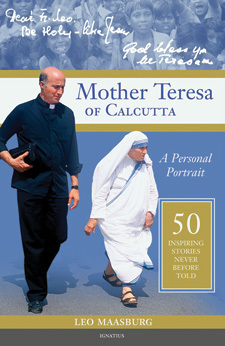 One of my favorite books published by Ignatius Press is
Mother Teresa of Calcutta
One of my favorite books published by Ignatius Press is
Mother Teresa of Calcutta
by Monsignor Leo Maasburg.
Msgr. Maasburg traveled with Mother for
many years and witnessed so many of Mother’s personal habits. Mother’s
sense of humor, her love of all God’s people, and willingness to do
whatever she was called to do, are presented in a way that is so
enjoyable to read. Mother’s spiritual life and commitment to God and
her work are expressed so honestly and openly for all of us to grasp,
appreciate, and imitate. Mother’s humility and total trust in God are
revealed over and over again throughout her life.
Reading this book renewed, for me, a total surrender to God of myself,
so God may use me in His vineyard, as He wills. I highly recommend this
book for readers that already have a devotion to Mother Teresa as well
as those who are waiting to meet her. Mother Teresa of Calcutta is also available as an e-book and audio download.
 Terese
Teresejoined Ignatius Press in 2009 as an account manager in the Retail Sales
Office and enjoys representing Ignatius Press and the vast number of
products available.
She has been a religious education teacher in her
parish for many years, and is a voracious reader of good Catholic books.
Before coming to Ignatius Press, Terese worked in the food service
industry. Terese and her husband Dan live in central Wisconsin,
enjoying their five children, their grandchildren, and the great
outdoors.
*Employee
Pick of the Week program features savings of 40% off a book, movie, or
compact disc personally chosen and recommended by an Ignatius Press
employee. Each week, an Ignatius Press employee will select a favorite
book, movie, or other Ignatius Press product and write a few sentences
about why he or she thinks customers will enjoy the particular
selection. A short bio of the selecting employee will also be included,
giving customers a chance to learn a bit more about the people who are
Ignatius Press.
October 23, 2012
G. K. Chesterton, a model for joyful evangelization
From a recent Catholic News Agency piece about Dale Ahlquist's new book, The Complete Thinker: The Marvelous Mind of G.K. Chesterton:
The author of a new book on G.K. Chesterton says the 20th-century
author and Catholic convert is a model for joyful evangelization who can
help unify the fractured modern worldview.
“Chesterton is the model evangelist,” American Chesterton Society
President Dale Ahlquist told CNA Oct. 18. He had a way to connect with
“virtually any kind of audience.”
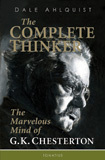
“He never lets his charity contradict his truth. He always puts them together,” Ahlquist said.
“That’s one of the great weaknesses of our world: you have some people
who care only about truth and doctrine, others who care only about
charity and pity, and they don’t let the two combine with each other.
Chesterton always combines the two.”
Ahlquist’s new book, “The Complete Thinker: The Marvelous Mind of G.K.
Chesterton,” was released this October (Ignatius Press, $17.95).
Chesterton lived from 1874 to 1936. Under the influence of his wife
Frances, he became a devout Anglican Christian. He converted to
Catholicism in 1922.
He wrote literary essays, novels, poetry, plays, philosophical works
and Christian apologetics. His short stories include the Father Brown
mystery series. He enjoys a reputation as a witty writer with a love of
finding truth in apparent paradox. He influenced the thinking of many
converts and writers.
“He wrote about everything,” Ahlquist said. “He has this amazing, wide reach.”
Ahlquist said his new book is intended to help get the reader “inside
of Chesterton’s head.” He aims to help people “think in a consistent
way” across disciplines and modes of life.
“The modern world, Chesterton points out, has become one wild divorce
court where everything has been separated from everything else,” he
explained.
“We have separated the arts from the sciences and the humanities from
the sciences. We have separated religion from politics and religion from
economics. We expect all these things to operate in their own
watertight compartments, and yet we don’t see how anything fits together
anymore.”
Read the entire piece. Also see the recent CWR interview with Ahlquist: "G. K. Chesterton, the Complete Thinker". Also see, on Ignatius Insight:
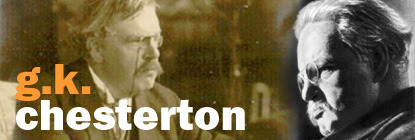
G. K. Chesterton (1874-1936) Author Page | Ignatius Insight
• Articles By and About G. K. Chesterton
• Ignatius Press Books about G. K. Chesterton
• Books by G. K. Chesterton
The Beginning of the End of the Abortion Industry?
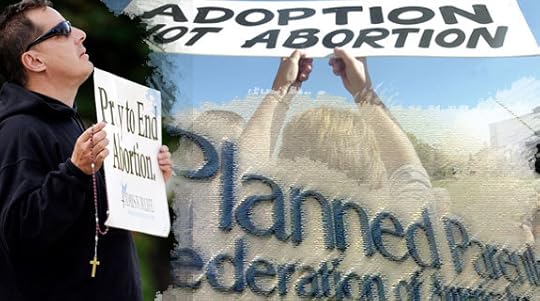
The Beginning of the End of the Abortion Industry? | Tim Drake | Catholic World Report
Over the past five years, growing numbers of US abortion workers have left the industry.
For
former Planned Parenthood director Abby Johnson, the turning point came when
she was asked to assist with an ultrasound-guided abortion.
“Abortions
are typically performed blind,” explained Johnson, who served as health
director for Planned Parenthood in College Station, Texas. “The doctor takes
the suction instrument and probes until he thinks he’s gotten everything.”
On
this particular day in the fall of 2009, “the visiting physician wanted to use
an ultrasound as a teaching tool to show us what an abortion looked like,”
recalled Johnson. “I was excited about the prospect of learning something new.
My job, during the procedure, was to hold the ultrasound probe on the patient’s
abdomen.”
What
Johnson saw on-screen would forever change her life.
“I
saw a 13-week-old child struggle and fight for its life during the procedure,”
said Johnson. “It was shocking for me because the most common question we were
asked in the counseling room was, ‘Will my baby feel this?’”
“Planned
Parenthood had come up with a scripted answer that we were to give women,” said
Johnson.
“Our
answer: No, the fetus has no sensory development until 28 weeks,” said Johnson.
“I wholeheartedly believed that.”
So
Johnson was stunned when she saw the child on the ultrasound screen trying to
get away from the intrusive instruments bent on its destruction.
“I
went back to my office, and for the first time during my eight years at Planned
Parenthood, I wondered if this was where I wanted to be for the rest of my
life,” said Johnson. “I sat down and prayed for the first time in many years.
All I knew was that I couldn’t do this anymore.”
Abby Johnson
On
October 6, 2009, one week and two days after participating in the abortion,
Johnson left Planned Parenthood and approached those gathered outside the
business who were in the midst of a 40 Days for Life campaign—volunteers
devoted to a prayerful, peaceful presence outside abortion businesses.
“I
broke down and told them, ‘I know what I’ve been doing is wrong, and I want
out,’” said Johnson.
Damascus Road
Johnson
isn’t the first to have experienced a Saul-to-Paul-like moment leading to a
departure from the abortion industry. In the decades since abortion’s
legalization, abortionists and abortion workers such as Dr. Bernard Nathanson,
Carol Everett, Anthony Levatino, and others were convicted by what they were
doing and experienced profound conversions. Some went on to publicly share their
testimony, such as Nathanson did in his 2001 book The Hand of God: A Journey from Death to Life by the Abortion Doctor Who
Changed His Mind.
Johnson’s
story is eerily similar to that of the late Joan Appleton’s 1989 departure as
head nurse of the Commonwealth Women’s Clinic in Washington, DC.
Appleton, too, had witnessed an ultrasound-guided abortion.
Theologians’ academic respectability
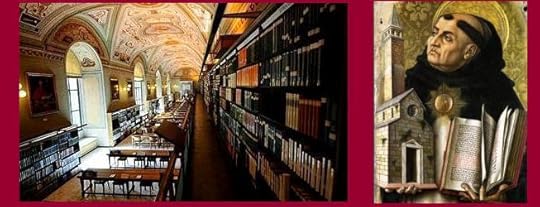
Theologians’ academic respectability | Fr. Kenneth Baker, S.J. | Homiletic & Pastoral Review | Editorial
The teaching authority of the Church is the only guarantee the theologian has for both his academic respectability, and his intellectual freedom.
Over the years, we have printed many articles on the proper
relationship that should exist in the Catholic Church, between the
Magisterium and the theologians. The problem has been, and is, a
perpetual one because the Apostles, and their successors (bishops), have
been commissioned by Jesus Christ to proclaim the Gospel to all
nations. An important function of the theologian is to analyze the
Gospel, question it, probe it, with a view towards understanding it more
adequately, and so being able to proclaim it more effectively in each
age of human history.
Recently I read a little book on this thorny question by the English
thinker, writer and lecturer, Mr. Christopher Derrick. The book is
entitled: Church Authority and Intellectual Freedom (Ignatius
Press, P.O. Box 18990, San Francisco, CA 94118). It is a collection of
four talks that he gave at Marquette University in Milwaukee in 1980.
The book is remarkable for a number of reasons. Derrick approaches
his subject matter in what seems to me to be a typical English fashion.
He lays great stress on the healthy skepticism of the scholar, who
requires painstaking investigation of his subject matter, established
methodology, and careful verification of all hypotheses and categorical
statements. The theologian, according to Derrick, if he is to have
academic respectability, and so deserve what is known as intellectual
freedom in the university, must abide by the usual norms of scholarship,
at least as they apply to his discipline. ...
October 21, 2012
Pope John Paul II and the Christ-centered Anthropology of "Gaudium et Spes"
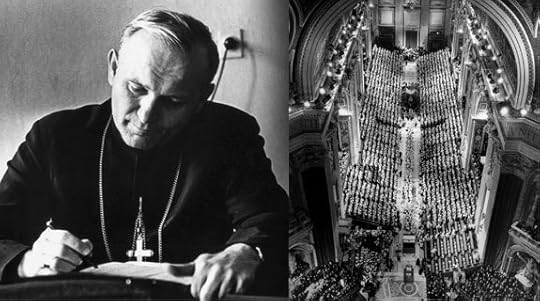
Pope John Paul II and the Christ-centered Anthropology of Gaudium et Spes" | Douglas Bushman | Catholic World Report
The late pontiff consistently summarized Gaudium et Spes in terms of the dynamism of its Christological anthropology.
Editor's Note: The following article originally appeared, in a slightly different form, in the July/August 2000 issue of Catholic Faith
magazine. It is republished here to mark the feast day for Blessed John
Paul II during the Year of Faith and the 50th anniversary of the Second
Vatican Council.
Introduction
A thorough study of the anthropology of Gaudium et Spes (GS) would be preceded by a study of the general purpose
of the Pastoral Constitution. This would include considerations of how Gaudium et Spes articulates the relation of the Church to the
world, and vice versa. It would also include its conception of the relationships of creation and redemption in Christ,
nature and grace, reason and faith. Detailed evaluation of these themes is beyond the scope of this article.
For our purposes it will suffice to become familiar with the way in which Pope John Paul II understood and
interpreted the pastoral purpose of Gaudium et Spes. That will follow these introductory remarks, which focus on the link between Gaudium et Spes
and Fides et Ratio.
That Pope John Paul II was profoundly formed by and faithful to the general pastoral purpose and style of Gaudium et Spes
throughout his pontificate is easy to show. He not only made constant reference to Gaudium et Spes, 22 and 24, referring to
the former as encapsulating the motif of his pontificate, his encyclical, Fides et Ratio, stressed the unity of the two
orders of knowledge, natural and supernatural. There is a "unity of truth" assured by the fact that God is Creator and
Redeemer and thus the Author of what is revealed through creation and through the economy of salvation.
The fundamental presupposition of Gaudium et Spes is precisely this unity of truth as it pertains to the human person, that is, to
anthropology. "For though the same God is Savior and Creator, Lord of human history as well as of salvation history, in
the divine arrangement itself, the rightful autonomy of the creature, and particularly of man is not withdrawn, but is
rather re-established in its own dignity and strengthened in it" (GS, 41). [1] There is a truth about the human person that
is accessible to those without faith. This truth is not only confirmed by revelation, but also deeply enriched by it.
How else can the Church enter into a dialogue with those without faith than to find some common ground, some starting
point upon which both are in agreement?
Fides et Ratio was an alarm bell. The more serene tone and optimistic outlook of Gaudium et Spes
ceded to a direct and serious
warning that the "crisis of man" had reached a new, critical point. [2]
Modern man has become so confused about himself that the very
presuppositions for human fulfillment have been nearly eradicated: that
there is objective and absolute truth; that man
is made to search out this truth; and that he is capable of discovering
it. These are under attack, being systematically
rejected. Without them there is no foundation for the dispositions that
create openness to a deeper understanding of the
meaning of life based on faith. And without those dispositions,
meaningful dialogue is impossible.
According to Fides et Ratio, if modern man is not searching for the meaning of life, then he lacks an essential openness to the
Gospel. For the Gospel is precisely "the definitive, superabundant answer to the questions that man asks himself about
the meaning and purpose of his life." [3] Indifference to religion has become indifference to truth, and living as if God
does not exist has led to the near annihilation of man's most characteristic action, seeking the truth.
In Fides et Ratio the Pope called for a rediscovery of the integrity of the created order and of man's place in it as one called to
realize himself by seeking and discovering the truth, and of the mutual complementarity of faith and reason. The
fundamental assertion of Gaudium et Spes about man is that by being faithful to himself in seeking the truth, he is in fact being
faithful to God, Who is the Author of human nature and thus of the innate desire to seek the truth. By seeking the truth
man is in fact seeking God: "For God has willed that man remain 'under the control of his own decisions,' so that he
can seek his Creator spontaneously, and come freely to utter and blissful perfection through loyalty to Him" (GS,
17). [4]
New: "The Complete Thinker: The Marvelous Mind of G.K. Chesterton"
Now available from Ignatius Press:
 The Complete Thinker: The Marvelous Mind of G.K. Chesterton
The Complete Thinker: The Marvelous Mind of G.K. Chesterton
by Dale Ahlquist
What does it mean to be a "complete thinker"? It means being able to
take on a wide variety of ideas and disciplines and put them all
together in a way that they work together. It means thinking like G.K.
Chesterton.
The English author G.K. Chesterton (1874-1936) was one of the most
prolific and well-known writers of his time, and one of the most widely
quoted in our own. For newspapers and magazines, he wrote social
commentary, literary criticism, and poetry with poignancy and wit.
Creator of the beloved detective Father Brown, Chesterton also wrote
novels and short stories.
"Thinking", wrote Chesterton, "means connecting things." His ideas are
not only connected to each other, they are also connected to us, showing
that the thought of Chesterton is timeless. In a world of increasing
specialization, Chesterton connects us to the big picture by helping us
see how the many and varied elements within our experience fit together.
He sheds light on almost every subject and opens doors from one thing
to another with dazzling clarity.
Drawing on literally hundreds of references from Chesterton's vast
writings, Dale Ahlquist conducts a symphony, with Chesterton playing all
the instruments in perfect harmony.
Chesterton's thoughts on almost everything-from east to west, from old
to new, from politics to economics, from Shakespeare to Dickens-are
woven together to create an illuminating whole.
Dale Ahlquist is president of the American Chesterton Society. Through his long running television series, The Apostle of Common Sense,
as well as his books and lectures, he has helped bring about a great
renewed interest in the works of G.K. Chesterton for contemporary
readers. He has authored and contributed to several books on Chesterton,
including Common Sense 101: Lessons from G.K. Chesterton, G.K. Chesterton: The Apostle of Common Sense, and In Defense of Sanity: The Best Essays of G.K. Chesterton.
"To write a book about Chesterton is a bold act since GKC's books render
most commentary superfluous. But Dale Ahlquist has not only had the
courage to make the attempt; he has the wit, the learning, and the grace
to make his book worthwhile reading alongside the works of the master
himself."
- Robert Royal, Faith & Reason Institute
"Dale Ahlquist is well known for his championing of the thought and
writings of the great English writer and apologist G. K. Chesterton. In
this book he has distilled years of reading and studying the writings
of his hero. It will surely attract many new readers to Chesterton.
Ahlquist himself has all the zeal of the convert and he will make many
new converts with this trenchant study."
-Ian Ker, Author, G. K. Chesterton: A Biography
"Dale Ahlquist is a delightful student of Chesterton who has learned
well from the Master. He combines Chesterton's amazing gift for being
funny and profound, showing how everything from pork to pyrotechnics
bears witness to the Maker of All in the great symphony of creation and
redemption. Pure reading pleasure!"
- Mark P. Shea, Author, The Heart of Catholic Prayer
Read a recent Catholic World Report interview with Dale Ahlquist about his new book:
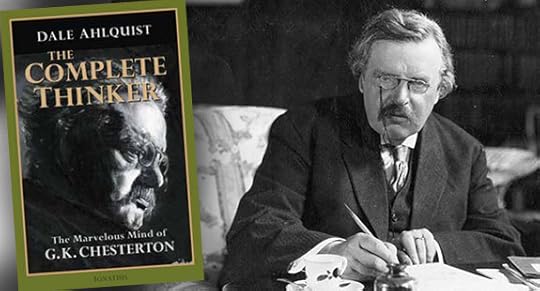
Saint Marianne Cope and Saint Kateri Tekakwitha
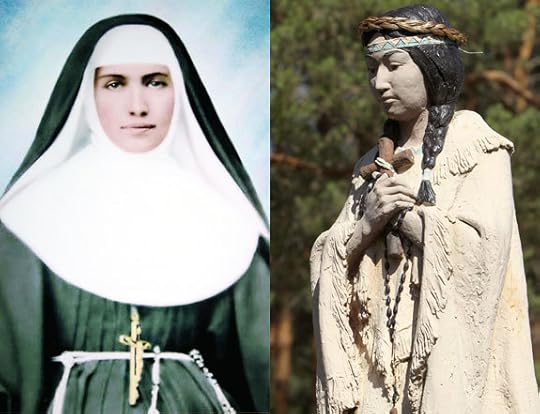
Pope Benedict XVI will today canonize seven new saints, four women and three men. From RomeReports.com:
Among the new saints, are two martyrs: Jacques Berthieu (1838-1896), who was killed in Madagascar and Peter Calungsod, who was killed in the Philippines in 1672.
Two others dedicated their life to teaching education: Carmen Sallés (1848-1911) was a pioneer in women's education and Giovanni Piamarta Battista (1841-1913) taught marginalized youths a marketable trade.
The three other saints offered their pain and suffering to God. Kateri Tekakwitha (1656-1680) was a Native American woman who helped the sick, even as she dealt with her own illness. Mother Marianne Cope (1838-1918) worked with lepers in Hawaii. Anna Schäffer (1884-1925) was sick most of her adult life. Despite being bedridden, through her words and letters she inspired people far beyond her native Germany.
Earlier this year, Brian O'Neel wrote about the two American saints-to-be for Catholic World Report. He pointed out that the news about Blessed Kateri Tekakwitha and Blessed Marianne Cope was notable for several reasons:
For starters, it was the first time the list had more Americans on it than those from other nations.
Second, it marked the first time the list had more than one American (two people and both New Yorkers, no less).
And, finally, it marked the first time the Church had marked a Native American for canonization.
The Americans in question are Bl. Marianne Cope and Bl. Kateri Tekakwitha, the better known of the two. As just one example of the fervor with which the news out of Rome was met, “The bells have been ringing here all morning,” said Rev. Mr. Ron Boyer, deacon at the parish in Kahnawake, Quebec, Canada, the village where Bl. Kateri died.
Just who were these remarkable women?
Read his entire article to learn more about these two new Saints.
October 20, 2012
No Cross, no Kingdom. Know the Cross, know the Kingdom.
A Scriptural Reflection on the Readings for Sunday, October 21, 2012 | Carl E. Olson
Readings:
• Isa 53:10-11
• Ps 33:4-5, 18-19, 20, 22
• Heb 4:14-16
• Mk 10:35-45
“No
pain, no gain.” The well-known saying became popular among exercise enthusiasts
in the 1980s. It was a motto for those who knew from experience that peak
physical fitness requires perspiration, pain, and commitment. Variations of the
sweaty slogan have been traced back to the seventeenth-century English poet
Robert Herrick, and Ben Franklin, in the 1734 edition of Poor Richard's Almanack, wrote: “There are no gains, without pains...”
None
of those sloganeers, I’m guessing, had the Passion and death of Jesus Christ in
mind. But it fits, even if only as a introductory summary. And today’s Gospel
could be given a similar slogan of sorts: “No Cross, no Kingdom.”
The
conversation between Jesus and the sons of Zebedee, James and John, is a bit
unsettling. It should certainly surprise anyone who thinks the disciples were
dutifully pious saints from the very beginning, or simply robotic “yes-men”
foils for Jesus. “Teacher,” they boldly—even impatiently and
demandingly—declared to Jesus, “we want you to do for us whatever we ask of
you.”
How
audacious! My initial thought is, “Who do they think they are? Don’t they know who they are talking to?” Then,
after further reflection, I have to admit how often I have approached Jesus in
the same way, making demands in the guise of thinly veiled impatience. I
need this done now, God! I want an answer immediately—and here’s the answer I
expect!
Of
course, God wants us to come to him with our problems and fears. But there is
an essential difference between approaching God with humble trust and telling
him, “Do what I ask of you!” The correct approach recognizes who we are in the
light of God’s revealed truth and love. “For me,” wrote St. Thérèse of Lisieux,
“prayer is a surge of the heart; it is a simple look turned toward heaven.”
James and John looked toward heaven, not with the simple humility of gratitude,
but with a selfish hunger for personal glory.
They
wanted to be rulers and sons of God, seated on the right and left hands of the
Lord. Perhaps they had in mind the well-known words of the Psalmist: “The LORD
says to my lord: ‘Sit at my right hand, till I make your enemies your
footstool’” (Ps. 110:1). Jesus provided the necessary reality check: “You do
not know what you are asking.” When we make demands of God, it indicates that
we have lost sight of who we are and what God desires us to be. This is why the
prayer given by Jesus to his disciples states, “Thy kingdom come, thy will be
done…”
It
is one thing to follow a teacher; it is quite another to follow the Son of God
to the Cross. As we heard in last week’s Gospel, the rich young ruler could not
follow Jesus because of his attachment to riches. Likewise, all of us struggle
with burdens, baggage, and desires that threaten to keep us from the Cross, or
tempt us to come down from it. As someone dryly observed, “The only problem
with a living sacrifice is it wants to crawl off the altar.”
Jesus
asked his disciples if they could drink the cup he would drink. Throughout the
Old Testament the cup often symbolized God’s judgment, and of the
death—ultimately spiritual in nature—waiting the unrepentant wicked. The only
man who didn’t deserve to drink the cup was the sinless God-man. But “through
his suffering,” God proclaimed through the prophet Isaiah, “my servant shall
justify many and their guilt he shall bear.” Willing to drink the deadly cup,
the risen Lord and great high priest now offers the life-saving cup of his
blood, the cup of the new and everlasting covenant which anticipates the feast
of the coming Kingdom (CCC 2837, 2861).
“Apart
from the cross,” St. Rome of Lima said, “there is no other ladder by which we
may get to heaven” (cf. CCC 618). No Cross, no Kingdom. Know the Cross, know
the Kingdom.
(This "Opening the Word" column originally appeared in the October 18, 2009, edition of Our Sunday Visitor newspaper.)
New from Ignatius Press: "A Noble Treason"
Now available:
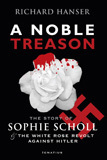 A Noble Treason The Story of Sophie Scholl and the White Rose Revolt Against Hitler
A Noble Treason The Story of Sophie Scholl and the White Rose Revolt Against Hitler
by Richard Hanser
Sophie Scholl and her brother Hans were handsome, bright university
students in 1942 Germany. As members of the Hitler Youth, they had once
been enthusiastic supporters of the German renewal promised by National
Socialism. But as their realization of Nazi barbarism grew, so did their
moral outrage.
Hans and Sophie formed a small group of like-minded friends, which
initially included two medical students, a student of philosophy, and a
fifty-year-old professor. They self-identified as Christians from
various traditions-Protestant, Catholic, and Orthodox-and they called
themselves the White Rose. In a darkened studio lent them by an artist,
they printed eloquent anti-Nazi leaflets, which they ingeniously spread
throughout Germany.
A Noble Treason tells the true story of this underground group
at the University of Munich that instigated, organized, and carried out
the first overt resistance to Hitler's regime. What gives A Noble Treason
its unforgettable and inspiring quality is the personality, character,
and courage of the White Rose members, as they resisted the pull of
wartime patriotism and overcame their fear of the terrible price they
would pay for their dissidence.
The story of the White Rose is one of faith-inspired idealism in deadly
conflict with ideological tyranny. Its theme is the ultimate victory of
that idealism despite its bloody-and seemingly final-destruction by the
state.
Richard Hanser served as a psychological warfare
specialist in Europe during World War II. He was a reporter and feature
writer for newspapers in Buffalo, Cleveland and New York before the war.
Afterward he wrote for documentary films and authored several books.
"I thought I knew the story of the White Rose pretty well, but Richard
Hanser provides detail, context, and insight that I have not previously
encountered. A Noble Treason is an exciting read and a tribute
worthy of the defiance and the sacrifices made by those students at the
University of Munich when they were under the thumb of Hitler's
minions."
- Ronald J. Rychlak, Author, Hitler, the War, and the Pope
"This vivid account gives witness to the true spirit of man. One can
only marvel at the patience, ingenuity and determination of these
students as they pit themselves against Hitler and his Third Reich.
Undeterred by the price to be paid if they were caught, their story
reminds us of what true courage is and of our responsibility to do what
is right...despite the odds."
- Kurt von Schuschnigg, Author, When Hitler Took Austria
October 19, 2012
"Eberstadt is at her best in highlighting both the ironies and tragedies of sexual liberation."
Janice Shaw Crouse, an Evangelical, Mary Eberstadt's book Adam and Eve After the Pill: Paradoxes of the Sexual Revolution (Ignatius, 2012) for The Family in America: A Journal of Public Policy:
Eberstadt is at her best in highlighting both the ironies and
tragedies of sexual liberation. She laments the “sexual doublespeak” of
popular women’s fashion magazines, a la Cosmopolitan, as they
reveal “a widely contradictory mix of chatter about how wonderful it is
that women are now all liberated for sexual fun—and how mysteriously
impossible it has become to find a good, steady, committed boyfriend at
the same time.” Children and young people, too, have suffered. A major
legacy of the sexual 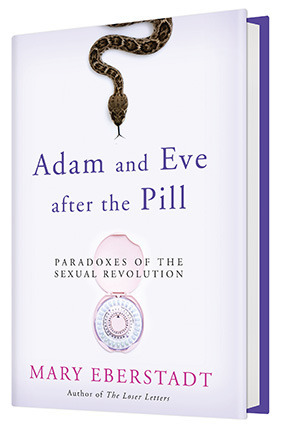 revolution, she laments, “is the assault unleashed
revolution, she laments, “is the assault unleashed
from the 1960s onward on the taboo against sexual seduction or
exploitation of the young.” Young people imbibe a “toxic collegiate
social brew made possible by the sexual revolution,” a revolution that
now includes date rapes, hook-ups, binge drinking, and pervasive
pornography. The toxic brew of today’s permissive culture, portrayed by
Tom Wolfe in his 2004 novel I am Charlotte Simmons: A Novel,
also features what Eberstadt calls contraception’s “permanent backup
plan”: abortion. Instead of “liberating women from the slavery of their
fertility” as some adversarial feminists claim, the Pill empowered a
sexual revolution by absolving men of responsibility and, as Kay
Hymowitz documents in Manning Up, left far too many in
permanent adolescence. The net effect is a climate of “sexual obesity”—a
phrase that Eberstadt borrows from University of Pennsylvania
psychiatrist Mary Ann Layden—a perfect storm that includes pervasive
pornography and attempts to mainstream pedophilia.
An unexpected dimension of the poisoned culture is the imposition of
ersatz morals, evident in new obsessions with so-called safe sex and
healthy eating, which have filled the vacuum left by the rejection of
common-sense morality. Citing shifts that took place in public attitudes
toward tobacco and pornography, Eberstadt believes these developments
reveal a great deal about our current situation. In the 1950s,
pornography was morally repugnant and tobacco smoking was entrenched in
the culture. At that time, family-centered morality governed sexual
behavior while food choices were morally neutral. Today, the moral
valences have been reversed: anything goes sexually, but food choices
carry moral significance. Borrowing from Friedrich Nietzsche, Eberstadt
terms these shifts “the trans-valuation of values,” meaning “the ways in
which the existing moral code would become transformed in a social
order no longer centered on Judeo-Christianity.” We can only hope that
by continuing to shine the spotlight of truth on the sexual-revolution
juggernaut, we can halt and then reverse the cultural pollution, the
widespread discontent, and the collateral damage.
.
Carl E. Olson's Blog
- Carl E. Olson's profile
- 20 followers



